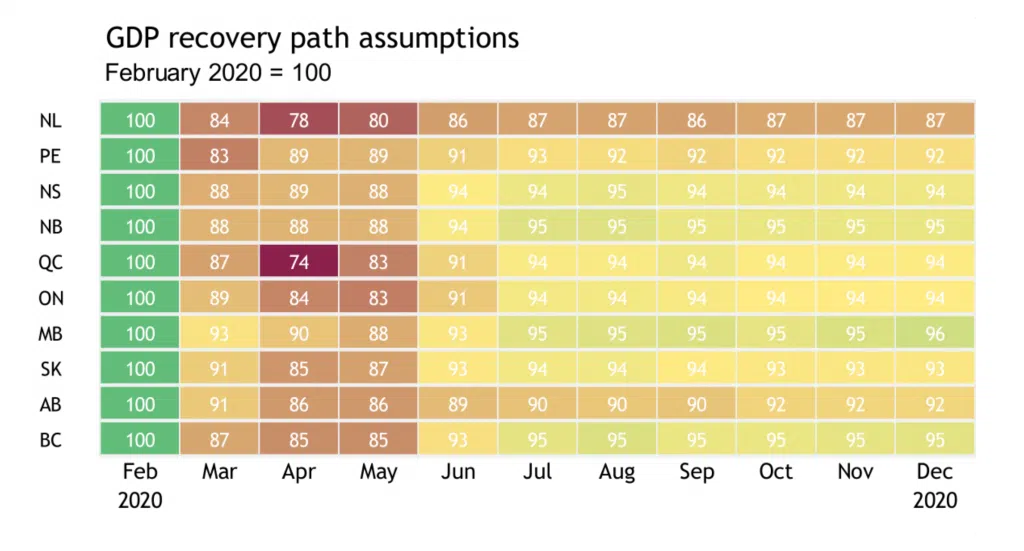A report by RBC Senior Economist Robert Hogue says New Brunswick, Manitoba and British Columbia will have a head-start in economic recovery, partly due to their success in containing the pandemic.
As all of Canada’s provinces are gradually reopening their economies, RBC is expecting a “meaningful economic recovery” in the second half of this year and into the next. The pace of that recovery won’t be the same across the country, though.
“Some provinces are proceeding a little more quickly than others with lifting lockdown restrictions—in part reflecting further progress at containing the pandemic. We believe this will give Manitoba, British Columbia and New Brunswick a head-start on the recovery,” Hogue wrote.
“Low oil prices pose an additional hurdle for oil-producing provinces leaving Newfoundland and Labrador, Alberta and Saskatchewan as the weakest performers.”
While all provincial economies are still expected to see severe contractions this year, those contractions “won’t be quite as massive as we thought previously,” Hogue notes.
He said the turning point was the labour data from May, which showed an earlier increase in jobs and hours worked than previously anticipated for most provinces. Other indicators, like housing starts and the bank’s proprietary consumer card spending data, also show some near-term strengthening.
In May, the bank had projected contractions ranging from -4.8 percent to -11.2 percent this year for provincial economies. Those would mark “the deepest recessions” the bank has ever seen.
“The GDP recovery path we assume for most provinces now generally has a slightly higher cyclical bottom in April-May compared to our May Provincial Outlook Update,” Hogue wrote. “We expect Manitoba, B.C. and New Brunswick will recover the most ground lost by year-end, with Newfoundland and Labrador, Alberta and PEI trailing all provinces.”
According to the report, New Brunswick would have recovered 95 percent of its February GDP by the end of the year. B.C. will do so at the same pace, and Manitoba will lead the country with 96 percent.
Nova Scotia will trail New Brunswick slightly at 94 percent, PEI at 92 percent and Newfoundland and Labrador at 87 percent.
The report also forecasts New Brunswick’s 2020 real GDP to fall by 5.3 percent, and grow by 2.7 percent in 2021. The unemployment rate is expected to sit at 10.4 percent this year and 8.3 percent next year. Retail sales will drop by 4.6 percent this year and grow by 4 percent in 2021.
Nova Scotia’s real GDP is expected to fall slightly more, by 5.5 percent this year, and grow by 3.8 percent next year. Unemployment will be 10.1 percent for 2020, and 8.4 percent in 2021. Retail sales will drop by 5.5 percent this year before growing by 4 percent next year.
P.E.I’s real GDP is expected to shrink 5.7 percent this year and grow by 3.5 percent next year. Newfoundland and Labrador will see the most contraction in its real GDP, -9.9 percent, this year. In 2021, that’s expected to grow by 2.7 percent.
In comparison, the country’s real GDP is expected to fall by 5.9 percent this year and expand by 4.2 percent next year. Unemployment will stand at 9.5 percent in 2020 and fall slightly to 7.6 percent the year after. Retail sales will drop 5.7 percent this year, and grow 4 percent in 2021.
“Full recovery will be a long and bumpy road for all provinces—easily stretching into 2022 or beyond in some cases. The maintenance of some forms of social distancing, permanent business closures, weakened balance sheets and lower in-migration will restrain the economic rebound,” Hogue wrote.
“We expect the impact of COVID-19 on some sectors like home construction will continue to grow well into 2021. Lower in-migration levels are poised to sap demand for new housing units, causing housing starts to fall in virtually every province next year. Still, despite many possible cross-currents, our forecast calls for positive economic growth to return from coast to coast in 2021—though this will say more about extremely low comparison point in 2020 than the degree of vitality in 2021.”
This story was originally published in Huddle, an Acadia Broadcasting content partner.








